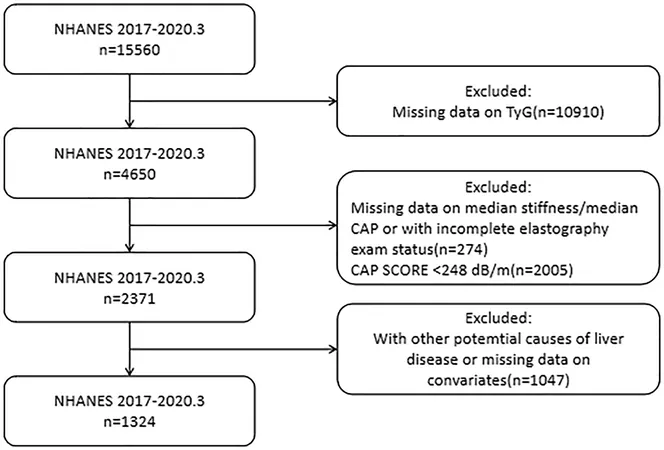
New Study Links Triglyceride-Glucose Index to Liver Fibrosis in U.S. Adults with Fatty Liver Disease – What You Need to Know!
2025-01-03
Author: Jia
Introduction
A recent cross-sectional study published using data from the National Health and Nutrition Examination Survey (NHANES) between 2017 and 2020 has uncovered a significant association between the triglyceride-glucose (TyG) index and liver fibrosis in adults suffering from Metabolic Dysfunction-Associated Steatotic Liver Disease (MAFLD). This finding raises crucial questions about how metabolic health impacts liver conditions and highlights an urgent need for increased awareness and preventative measures.
Key Objectives and Methods
The goal of the study was to explore how the TyG index—a composite marker of serum triglycerides and fasting glucose—relates to the severity of liver fibrosis among a diverse sample of 1,324 U.S. adults diagnosed with MAFLD. The researchers defined significant fibrosis as a liver stiffness measurement of 8.2 kPa or higher, leveraging advanced ultrasound techniques for accurate assessments. To analyze the data, multivariable logistic regression models were employed, adjusting for confounding factors like age, gender, race, and metabolic health indicators. A novel aspect of this study involved employing a restricted cubic spline model, revealing potential nonlinear relationships between TyG levels and liver fibrosis risk.
Study Findings
Among the participants, 137 exhibited significant liver fibrosis. Statistical analysis showed that higher levels of the TyG index were significantly correlated with an increased incidence of liver fibrosis associated with MAFLD (Odds Ratio (OR) = 2.18). Notably, this risk escalated in women (OR = 2.53) compared to men (OR = 1.95), and was particularly pronounced among obese individuals and those aged 40 to 59 (OR = 2.85). The study also indicated a threshold for concern: TyG index values exceeding 8.054 were linked to significant fibrosis. The predictive capacity of the TyG index was moderate but notable, with an area under the ROC curve (AUC) of 0.73, suggesting that healthcare providers could use this index to identify individuals at risk of liver complications.
Understanding MAFLD and Its Implications
MAFLD has emerged as a growing public health concern. Affecting over 25% of the global population, this condition is intricately linked to obesity, diabetes, and other metabolic disorders. It is increasingly recognized as a precursor to severe outcomes such as cirrhosis and liver cancer. The findings from this study underscore the urgent need to focus on metabolic health as a means of addressing liver disease risk. The study posits that insulin resistance (IR) may be a crucial underlying mechanism contributing to liver fibrosis progression, reinforcing the importance of comprehensive metabolic assessments.
What You Should Take Away
- **Awareness:** The correlation between TyG index levels and liver fibrosis emphasizes the necessity for routine health checks that include metabolic markers, especially for at-risk populations. - **Preventative Action:** As the obesity epidemic continues, establishing lifestyle interventions focused on improving metabolic health is more critical than ever. This includes promoting nutrition education, increasing physical activity, and reducing sedentary behavior. - **Further Research:** The research community continues to seek a clearer understanding of MAFLD. This includes investigating how nutritional factors, endocrine dysfunction, and gut microbiota contribute to liver disease progression.
Conclusion
The study enhances our understanding of the interaction between metabolic health and liver fibrosis, offering valuable insights for healthcare professionals and the general public alike. While a direct causal relationship cannot be established from this cross-sectional data, the implications underscore the importance of early diagnosis and timely intervention for individuals with elevated TyG indices. As we continue to navigate the complexities of metabolic diseases, findings like these propel us toward a more holistic approach to health that integrates metabolic and liver health. Acting now could pave the way for better health outcomes in populations at risk, ensuring a healthier future for millions.
 Brasil (PT)
Brasil (PT)
 Canada (EN)
Canada (EN)
 Chile (ES)
Chile (ES)
 Česko (CS)
Česko (CS)
 대한민국 (KO)
대한민국 (KO)
 España (ES)
España (ES)
 France (FR)
France (FR)
 Hong Kong (EN)
Hong Kong (EN)
 Italia (IT)
Italia (IT)
 日本 (JA)
日本 (JA)
 Magyarország (HU)
Magyarország (HU)
 Norge (NO)
Norge (NO)
 Polska (PL)
Polska (PL)
 Schweiz (DE)
Schweiz (DE)
 Singapore (EN)
Singapore (EN)
 Sverige (SV)
Sverige (SV)
 Suomi (FI)
Suomi (FI)
 Türkiye (TR)
Türkiye (TR)
 الإمارات العربية المتحدة (AR)
الإمارات العربية المتحدة (AR)